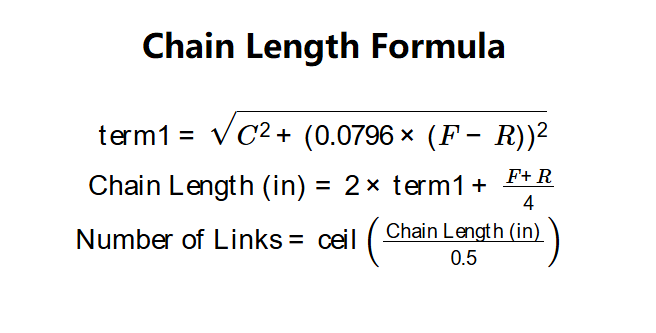1. What is a Chain Length Calculator?
Definition: This calculator computes the required chain length for a bicycle in both the number of links and physical length (mm, cm, m, in, ft), based on the chainring size, cog size, and chainstay length.
Purpose: It helps cyclists determine the correct chain length to ensure proper fit and function of the drivetrain, avoiding issues like chain slack or excessive tension.
2. How Does the Calculator Work?
The calculator uses the following formula to determine the chain length in inches:
\( \text{term1} = \sqrt{C^2 + (0.0796 \times (F - R))^2} \)
\( \text{Chain Length (in)} = 2 \times \text{term1} + \frac{F + R}{4} \)
Where:
- \( C \): Chainstay length (in inches).
- \( F \): Chainring size (number of teeth).
- \( R \): Cog size (number of teeth).
The number of links is then calculated as:
\( \text{Number of Links} = \text{ceil}\left(\frac{\text{Chain Length (in)}}{0.5}\right) \)
Since each chain link is 0.5 inches long (standard pitch). The physical chain length is recalculated as:
\( \text{Chain Length (in)} = \text{Number of Links} \times 0.5 \)
And then converted to the selected unit (mm, cm, m, in, ft), with the default unit being inches.
Steps:
- Enter the Chainring Size and Cog Size (in number of teeth).
- Enter the Chainstay Length and select its unit (mm, cm, in).
- Validate inputs to ensure they are non-negative and logical (e.g., Chainstay Length > 0).
- Compute the Chain Length in inches using the formula.
- Calculate the Number of Links by dividing by 0.5 inches per link and rounding up.
- Recalculate the physical Chain Length based on the Number of Links, then convert to the selected unit (defaulting to inches).
- Display both the Number of Links and the physical Chain Length with a unit conversion dropdown.
3. Importance of Chain Length Calculation
Calculating the correct chain length is crucial for:
- Drivetrain Performance: Ensures smooth gear shifting and efficient power transfer.
- Safety: Prevents chain derailment due to incorrect tension.
- Component Longevity: Reduces wear on the chain, chainring, and cog by ensuring proper fit.
4. Using the Calculator
Example 1: A user has a chainring with 48 teeth, a cog with 16 teeth, and a chainstay length of 420 mm, preferring the physical length in cm:
- Chainring Size: 48 teeth
- Cog Size: 16 teeth
- Chainstay Length: 420 mm = \( 420 \times 0.0393701 = 16.54 \, \text{in} \)
- Chain Length (in): \( \text{term1} = \sqrt{16.54^2 + (0.0796 \times (48 - 16))^2} \)
- Step 1: \( 0.0796 \times (48 - 16) = 0.0796 \times 32 = 2.55 \)
- Step 2: \( 16.54^2 + 2.55^2 = 273.57 + 6.49 = 280.06 \)
- Step 3: \( \sqrt{280.06} \approx 16.74 \)
- Step 4: \( 2 \times 16.74 + \frac{48 + 16}{4} = 33.47 + 16 = 49.47 \, \text{in} \)
- Number of Links: \( \text{ceil}(49.47 / 0.5) = \text{ceil}(98.94) = 99 \)
- Chain Length (in): \( 99 \times 0.5 = 49.50 \, \text{in} \)
- Default Result: Chain Length = 49.50 in
- Selected Unit (cm): \( 49.50 \times 2.54 = 125.73 \, \text{cm} \)
- Result: Chain Length = 125.73 cm, Number of Links = 99 links
Example 2: A user has a chainring with 52 teeth, a cog with 12 teeth, and a chainstay length of 16 in, preferring the physical length in ft:
- Chainring Size: 52 teeth
- Cog Size: 12 teeth
- Chainstay Length: 16 in
- Chain Length (in): \( \text{term1} = \sqrt{16^2 + (0.0796 \times (52 - 12))^2} \)
- Step 1: \( 0.0796 \times (52 - 12) = 0.0796 \times 40 = 3.18 \)
- Step 2: \( 16^2 + 3.18^2 = 256 + 10.14 = 266.14 \)
- Step 3: \( \sqrt{266.14} \approx 16.31 \)
- Step 4: \( 2 \times 16.31 + \frac{52 + 12}{4} = 32.63 + 16 = 48.63 \, \text{in} \)
- Number of Links: \( \text{ceil}(48.63 / 0.5) = \text{ceil}(97.26) = 98 \)
- Chain Length (in): \( 98 \times 0.5 = 49.00 \, \text{in} \)
- Default Result: Chain Length = 49.00 in
- Selected Unit (ft): \( 49.00 \times 0.0833333 \approx 4.08 \, \text{ft} \)
- Result: Chain Length = 4.08 ft, Number of Links = 98 links
5. Frequently Asked Questions (FAQ)
Q: What is a chainstay on a bicycle?
A: The chainstay is the part of the bike frame that connects the bottom bracket (where the chainring is mounted) to the rear wheel axle.
Q: Why is each chain link 0.5 inches long?
A: The standard pitch of a bicycle chain is 0.5 inches, which accounts for one full link (an inner and outer link pair).
Q: What if my calculated chain length is too short or too long?
A: If the chain is too short, it may not fit around the chainring and cog, causing tension issues. If too long, it may cause slack, leading to derailment. Adjust by adding or removing links, ensuring proper tension.
Chain Length Calculator© - All Rights Reserved 2025
 Home
Home
 Back
Back
